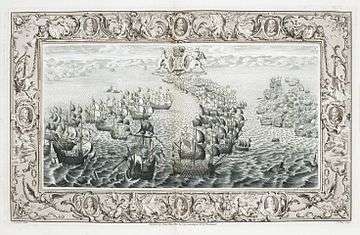San Salvador (Guipúzcoan squadron)
San Salvador was a Spanish galleon of the Spanish Armada as part of the Guipúzcoan squadron of Miguel de Oquendo.[1] She was damaged and captured as a result of the first encounter of the Armada with the Royal Navy in 1588. San Salvador was lost at sea in the English Channel later that same year.
- The article you are about to read is about a ship from the Spanish Armada.
| History | |
|---|---|
| Name: | San Salvador |
| Honours and awards: | Vice-flagship: Guipúzcoan squadron |
| Captured: | 1 August 1588 (English) |
| Fate: | Wrecked |
| General characteristics | |
| Tons burthen: | 958 (Spanish rating) 600 (English assessment) |
| Armament: | 25 guns |

Capture
During the first encounter with the English fleet on 31 July 1588, during a lull in battle, San Salvador's gunpowder magazine exploded, lighting a portion of the ship on fire.[1] The Spanish fleet was able to extinguish the flames and rescue some of the injured.[1] 49 crew died as a result of this explosion and 23 had died previously due to combat.[2] On 1 August, San Salvador was ordered to be scuttled, but instead was simply set adrift.[3] The English dispatched an inspection party to San Salvador and found approximately fifty burnt bodies aboard.[3] Golden Hind, a ship in the English fleet, then towed San Salvador to the English port at Weymouth.[3]
Significance
San Salvador was one of the heaviest armed in the Spanish fleet.[4] The Spanish records rate the ship at 958 tons, while the English assessment rated the ship at only 600 tons.[5] These are the only numbers available for calibration of the reported vessel tonnage between the two fleets (the Spanish tended to give higher ratings).[5] Between San Salvador and Rosario (another ship captured during the first encounter), the English retrieved a significant amount of cannon shot and powder. One estimate places the 229 barrels of powder captured from these two ships at one quarter the total used by the English during the entire campaign.[6]
After the campaign
San Salvador became known as the Great Spaniard to the English fleet after her capture.[7] On 15 November 1588, notice was sent to Lord Charles Howard that San Salvador had been lost at sea at Studland.[7] Twenty-three men died with the ship; thirty-four were saved by a small man-of-war.[7] A wreck discovered in 1983 in Studland Bay was initially believed to be the San Salvador but is now thought to be a Spanish merchant ship, Santa Maria de Luce.[8]
See also
References
- Milne-Tyte, Robert (1998) [1988]. Armada!. Wordsworth Military Library. Great Britain: Wordsworth Editions Limited. pp. 58. ISBN 1-85326-688-4.
- Martin, Colin; Geoffrey Parker (1999). The Spanish Armada. Manchester University Press. pp. 241. ISBN 1-901341-14-3.
- Milne-Tyte, Robert (1998) [1988]. Armada!. Wordsworth Military Library. Great Britain: Wordsworth Editions Limited. pp. 64. ISBN 1-85326-688-4.
- Martin, Colin; Geoffrey Parker (1999). The Spanish Armada. Manchester University Press. pp. 149. ISBN 1-901341-14-3.
- Martin, Colin; Geoffrey Parker (1999). The Spanish Armada. Manchester University Press. pp. 206. ISBN 1-901341-14-3.
- Martin, Colin; Geoffrey Parker (1999). The Spanish Armada. Manchester University Press. pp. 197. ISBN 1-901341-14-3.
- Boddie, John Bennett (April 1934). "Boddie of Essex, England and Virginia". William and Mary College Quarterly Historical Magazine. 14 (2): 114–140. JSTOR 1915674.
- Historic England. "Studland Bay Wreck (1000045)". National Heritage List for England. Retrieved 15 March 2012.